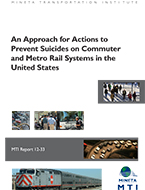- 408-924-7560
- mineta-institute@sjsu.edu
- Donate
An Approach for Actions to Prevent Suicides on Commuter and Metro Rail Systems in the United States
The primary goals of this report are to discuss measures to prevent suicides on commuter and metro rail systems, and to outline an approach for suicide prevention on rail systems. Based on existing literature and analysis of data obtained from the Metrolink system in Southern California, it was found that most suicides occur near station platforms and near access points to the track. Suicides occurred most frequently when relatively more trains were in operation and in areas of high population density. There do not appear to be suicide “hot spots” (e.g., linked to mental hospitals in the proximity, etc.), based on data analyzed for U.S. systems. The suicide prevention measures range from relatively inexpensive signs posting call-for-help suicide hotline information to costly platform barriers that physically prevent people from jumping onto tracks in front of trains. Other prevention measures fall within this range, such as hotlines available at high frequency suicide locations, or surveillance systems that can report possible suicide attempts and provide the opportunity for intervention tactics. Because of the relatively low number of suicides on rail systems, as compared to the overall number of suicides in general, a cost-effective strategy for preventing suicides on rail systems should be approached in a very focused manner. The prevention measures executed by the rail authorities should be focused on the suicides occurring on the rail systems themselves, while the broader problem of suicides should be left to community-based prevention efforts. Moreover, prevention measures, such as surveillance and response, could “piggyback” on surveillance and response systems used for other purposes on the rail systems to make such projects economically feasible.
JAN L. BOTHA PhD
Jan Botha, PhD, is a professor at the Department of Civil and Environmental Engineering at San Jose State University. Dr. Botha has nine years’ experience in transportation engineering practice and has been a faculty member at the University of Alaska, Fairbanks, and at SJSU for a total of 24 years. Dr. Botha received a PhD and MS in transportation engineering from University of California Berkeley, and a B Sc and B Sc (Hons.) in civil engineering from the University of Pretoria, South Africa.
MARISSA K. NEIGHBOUR
Marissa Neighbour, BS, graduated from San Jose State University with a Bachelor of Science in civil and environmental engineering in Spring 2014. She is continuing her education in the Master’s program at the University of California, Davis with a concentration in structural engineering
SATNAM KAUR
Satnam Kaur has been a research assistant at San José State University since Spring 2013. She will be graduating from SJSU in Fall of 2014 with a Bachelor’s Degree in civil engineering. Her research interests pertain to transportation safety, more specifically the effects of bike sharing and bicycle safety.
-
Contact Us
SJSU Research Foundation 210 N. 4th Street, 4th Floor, San Jose, CA 95112 Phone: 408-924-7560 Email: mineta-institute@sjsu.edu






